
With an open and candid review, Akio Toyoda kicked off the annual General Shareholder Meeting for 2020, outlining the events leading to Toyota's present and what the company is focusing on today.

On June 11, 2020, Toyota Motor Corporation held its 116th Ordinary General Shareholder Meeting. A company is required to convoke its shareholder meeting within three months of the end of its business year; since Toyota concludes its business year on March 31, the company must hold its shareholder meeting by the end of June.
To help prevent the spread of COVID-19 at this year’s shareholders’ meeting, a variety of measures were implemented, such as placing transparent screens between the shareholders and the executives.
At the designated time, the chair, President Akio Toyoda, announced the start of the meeting. First, the shareholders watched a business report video, then Akio made some opening comments to the shareholders. Following that was a Q&A session, and upon its conclusion, Akio provided closing comments and the voting commenced.
This year, Akio’s opening comments focused on Toyota’s efforts in strengthening its corporate composition and his own personal thoughts on the financial results announcement.
Although Akio had provided an explanation at the recent financial results press conference about how Toyota’s corporate composition has been strengthened since he became president, the audience was different this time. This time he was talking to shareholders, those that share in the ownership of the company. Shareholders are people who “have invested in Toyota with expectations for the company to succeed” and who “are partners that fight together with Toyota.”
For Akio, the shareholder meeting is “the opportunity we have each year to communicate directly with our shareholders.” To clarify how he views this meeting to those within the company, he sometimes describes what the meeting is for in the following manner:
Facing the shareholders, Akio revealed his innermost thoughts—things he dared not say to the media.
To help readers better understand Akio’s thoughts and the other things he decided to share with the shareholders, Toyota Times will provide a series of stories.
<Akio’s Opening Comments>
*Video available following the article
Here, I would like to discuss how Toyota is strengthening its corporate composition.
Since I became president in 2009, we have faced numerous crises; as we have overcome them, I believe that our company has gradually strengthened its corporate composition.
For the three years immediately preceding the global financial crisis, we reaped the benefits of a favorable exchange rate and increased sales to grow our operating income. However, convinced that we would be able to sell whatever we produced, we increased our production capacity by more than 500,000 units per year, leading to a significant increase in fixed costs.
This was a period when Toyota received wide admiration from around the world. We blindly rode the momentum of the times and expanded at a scale that was beyond our means. I think this resulted in us not fully focusing on our human resources development, which led to our recall crisis later.
In the year immediately after the global financial crisis, a significant fall in new vehicles sales was compounded by a strong yen. Toyota fell to a deficit of 461 billion yen.
In the four years immediately after I became president, we were faced with and united to overcome a number of crises, including the massive recall crisis and the Great East Japan Earthquake. Thus, we were able to bring the number of new vehicles sold back up to the levels we had before the global financial crisis.
At the same time, we drastically reduced our fixed costs, and despite the ultrahigh yen of an exchange rate of 83 yen to the dollar, we achieved an operating income of more than one trillion yen.
However, since we had reduced, and in some cases stopped, our R&D expenses and capital investments across the company simultaneously, it took time before we would genuinely recover.
Now, looking back, I truly believe that “it was the only choice we had.”
At that time, my reforms were constantly under the microscope and I was continuously having to prove myself. If things didn’t go well, even a little, then an “I told you so” mood quickly enveloped the company.
As a consequence, this was a time when I devoted myself to the pursuit of a single goal: “We must make a profit. We cannot do anything unless we make profits.”
Also, Toyota, at that time, was recording losses. We could not pay our taxes.
A company whose precepts include the spirit of being “contributive to the development and welfare of the country” was unable even to pay its taxes—the most basic form of social contribution.
I will never forget the regret and shame I felt then.
I swore to myself that “making a loss is unacceptable.”
Over the past seven years, Toyota has strengthened its corporate composition: by making cost reductions, we have been able to absorb the increase in fixed costs resulting from TNGA and CASE investments for accelerating the making of ever-better cars.
In the first three of those years, we aimed to strengthen our true competitiveness during what we termed an "intentional pause." But my self-assessment was that I was not able to obtain sufficient results.
This "intentional pause" made me keenly feel the difficulty of carrying out reforms in what we called “normal times”.
Within the company, over time a consciousness had taken hold that Toyota was doing fine; a corporate climate had taken root in which considerations were made about things based on that premise. Perhaps what led me to earnestly engage in reforming these things was my own “intentional pause.”
To compound matters, we were facing and continue to now face a once-in-a-century period of profound transformation. As such, over the past few years, we have been feverishly engaging in both "a fight to bring back what makes us Toyota" and "completely redesigning Toyota for the future."
During that period of struggle, we believed that management would have to change first to change the company in this uncharted era, so we took various measures to fundamentally revise our executive and organizational structure, including the introduction of an in-house company system, the establishment of our “Seven Samurai” (the president and six executive vice presidents) structure, and, more recently, the discontinuance of the post of executive vice president. Our revisions covered not only people actively filling posts but also our advisor system.
When it came to communicating with our employees, such as during the spring labor consultations [in Japan], we made genuine efforts to achieve true mutual understanding. Labor and management at Toyota share a common foundation: "the company desires the happiness of its employees, and the labor union desires the growth of the company."
During this period of profound transformation, we earnestly desired the happiness of our employees; we chose to re-evaluate what we had previously taken for granted, such as raising base wages and implementing uniform wage increases. The company and labor union are holding thorough discussions as part of striving to fundamentally reform how we work.
While making efforts in making ever-better cars and bringing back what makes us Toyota such as the Toyota Production System (TPS) and thorough cost planning, we have been actively promoting an environment wherewith we can build partnerships for the future.
Our basic stance is that alliances are not for taking control of partners based on the logic of capital, but rather for respecting each other and for cooperating through work with like-minded partners. As a result, within an extremely short period of time, we have been able to establish a network with many partners, including those from other industries.
In addition to expanding new partners, we have strengthened cooperation within the Toyota Group. Now, beyond a desire to become strong as an individual company, we now seek to become strong together as a group, based on our new "home & away" strategy.
As we undergo a "complete redesign" into a mobility company, we are also engaged in reorganizing our assets—revising our cross-shareholdings and selling underutilized real estate.
As a consequence of these reforms over the last eleven years, we have managed to lower our break-even point by more than two million units compared to the global financial crisis periods. This is what has led to contributing to the favorable March 2020 financial results regardless of the COVID-19 crisis.
Our financial results for March 2020 show that we managed to maintain operating income of over 2.4 trillion yen. We succeeded in limiting our drop in operating profits to just one percent year-on-year even though there was some impact on our business from COVID-19 in the fourth quarter.
For the current running term to March 2021, we were able to announce a forecast with an operating income of 500 billion yen.
Generally speaking, I think it has been and continues to be difficult for companies to make forecasts for the current year ending March 2021. Yet, Toyota has chosen to provide a forecast because I thought it was our responsibility to share some kind of guidance, as a key member of the automotive industry that has a wide range of suppliers and businesses, given that the industry has wide-ranging ripple effects on the Japanese economy.
By offering our guidance, I thought that it would enable numerous other parties to draw up some sort of plan, and the ripple effect of that would benefit society as a whole.
As we look at our financial results, we must realize that they are the results of overcoming our challenges in the last 11 years, so I wanted to use time here again to explain such efforts. I humbly request your continued understanding and support.
Following his opening comments, the General Shareholder Meeting Q&A session started. Coming up in the next story on Toyota Times will be coverage of some of the highlights from that session -- Stay tuned!

